Every year, we give over all of December (and usually most of January) to a series called ‘Shadows and Reflections’, in which our contributors share highs, lows and oddments from the past 12 months. Today it’s the turn of Melissa Mouchemore.
A Large Tuft of Herbs
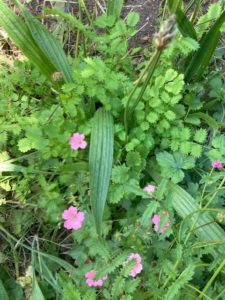
Late in 2021 the trampoline was finally free-cycled. It wasn’t quite as big as our London back garden but it dominated the space. I am grateful for its years of service; my small boys ping-ponging in pyjamas, never going to bed. How else to wear them out? A hamster wheel for kids.
But those days are gone and so finally is the trampoline.
Leaving us with a trampoline sized and shaped bald patch, some strands of yellow grass attempting a comb-over, one hardy tuft of shrub trying to grow out from where the trampoline’s shadow had fallen. A new space.
What to do with it? Dig a pond? Too much effort. How about a no-mow patch? I had seen encouraging photos on Nature Twitter. It looked like my kind of gardening. Leave it and see what happens. Probably nothing except grass.
But it wasn’t nothing. And it wasn’t just grass.
I am not sure what came first or when. It was such a scramble. There was comfrey. There was ribwort plantain. Joined by red clover, broad-leaved willowherb, creeping thistle. Their names didn’t necessarily trip off my tongue but I had an app.
On a junior school trip once square frames were handed out — they were quadrats we were told. We had to stand in a field and throw them like quoits. Wherever they landed we were to take a look only at what was growing in that square and then draw it on a worksheet attached to a clipboard. I was fascinated by the idea — what child doesn’t love a small world? And now the footprint of the trampoline had given me a quadrat of my own, one I could visit every day. In early spring the old bench was dragged into pole observing position, the quadrat laid out before me.
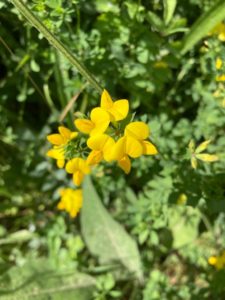
The app is sniffy about much of what it identifies — the words ‘noxious’, ‘invasive’ and ‘aggressive’ along with the term ‘weed’ are often mentioned. Normal habitats are ‘roadsides and waste ground’. They are also all ‘very common’. It advises me how to get rid of the bird’s foot trefoil that is knitting its way across the quadrat but its buttery flowers tremble with bees. I can’t deprive them.
I turn to Flora Britannica — on a shelf for reference for decades but mostly not referred to. This is what I need. Richard Mabey’s irrepressible enthusiasm, wonder and curiosity. Mabey sometimes gives the same information as the app but much more positively; he replaces ‘aggressive’ and ‘invasive’ with ‘abundant’ and ‘expansive’. And so, I read, the Bristly Ox-tongue is also known as ‘Milton Keynes weed because it is so abundant and expansive in the city.’ On hot July mornings in the quadrat I greet its sunburst yellow flower and the highly polished hoverfly it wears like a brooch.
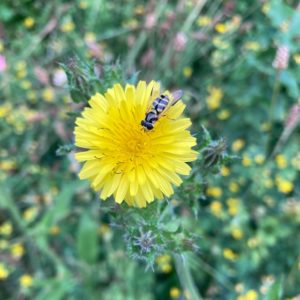
I fall in love with the names as much as the plants;
Enchanter’s nightshade: a tiny plant hesitating at the edge of the quadrat, miniature double bells of cream-pink stippling a background of lush leaves. Everything in twos — petals, stamens, sepals, seeds.
Musk mallow: Leaves like a hand being offered. Blousy blooms inviting into its generous white heart any pollen-loving creature who hums, buzzes or zips.
Herb Robert: So sassy with bright red stems striking out in all directions, nylon pink flowers dancing. No wonder it has a name like an American band leader. I realize guiltily that I used to pull this ‘weed’ out of the flower bed by the kitchen door. Why? It has got flowers. I used to pull it out so that I could drive to the garden centre and buy something flowery to put in its place. Madness.
It isn’t just their names and appearance I am revelling in. Mabey reveals the plants’ superpowers.
So I learn that the common self-heal that has clustered in one spot, its violet stud earrings set off against bright green blades, is still used in Chinese medicine. And the feverfew that has somehow drifted into the quadrat is not just bee friendly, with long-lasting flower heads that I can cut and put in a jug; it is also clinically proven to help migraine sufferers. It is a gift of a plant.
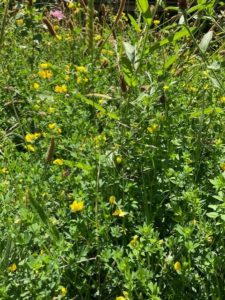
In searing August, when we are often confined to the protection of the house, the garden takes a hit like every other green space in London. But the quadrat fares better. Salad burnet has sprung up with rusty bottle-brush flower heads and feathery bouquets that remain as green as a bowling lawn thanks to its deep hardy roots. Its miniature hand-fan leaves release a cooling cucumbery scent when picked so I pop some in a Pimms as the light finally fades. I never imagined that I could start foraging from the quadrat.
And there is more harvesting at my feet. Dandelions, which used to suffer the same fate at my hands as the herb robert, join forces with the burnet to form a lush salad bowl. When the rain finally arrives in September it nicely rinses the leaves. I nibble a jagged triangle — like bitter lettuce. I will make dandelion sandwiches this autumn.
Looking down on the garden from a top window I have to confess my beloved quadrat is not a looker — it is not the sort of blissful meadow that Julie Andrews might run through. It looks like a patch of abandoned waste ground. The app might have a point. I wonder what the neighbours think of it compared to their own quadrats of astroturf, neat lawn, sun-lounger patio or concrete yard.
But then in Flora Britannica I come across a sepia watercolour that catches my breath. Looking through, not down on, a mesh of end-of-season meadow-grass, yarrow, plantain and dandelions; everything straggly, bare-patched, raggedy. The most eye-catching tangle. Large Tuft of Herbs by Albrecht Durer (1503) is an acutely observed and painted close-up of a square foot of meadowland. Here is someone who understood the worth of a wild quadrat and the wealth within its boundaries, someone who knew the infinite pleasures of gazing at a no-mow patch long before the term was coined.
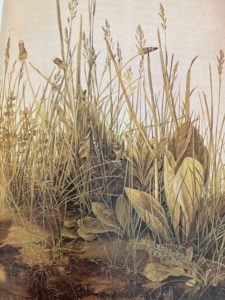
I am still sitting out on the bench in November in mild temperatures that would have rightly confused Albrecht Durer. They more than confuse me. The quadrat is finally realizing it is no longer summer and is settling into the nearest London has to a winter mode. The app was right to some — the bird’s foot trefoil mat will have to be cut back to allow new growth in spring. And I will have to keep an eye on the creeping thistle.
But not mowing and just leaving be has done so much more than fill a gap – it has conjured up a world of cooling, breathing, nourishing, healing beauty. I hope I will be grateful for its service for many years to come.